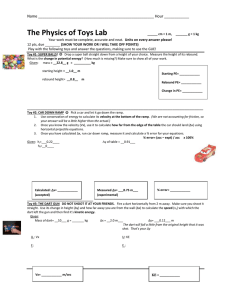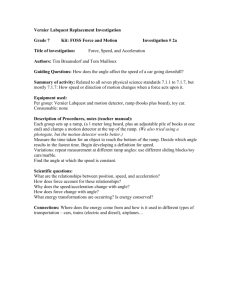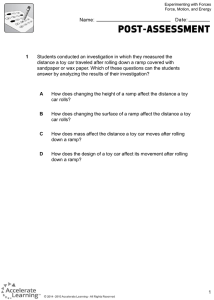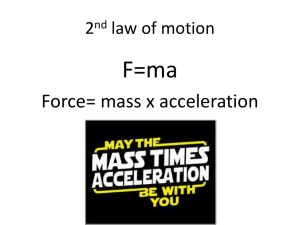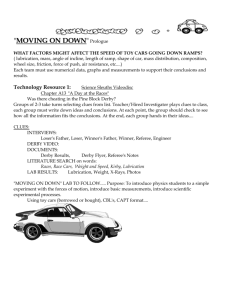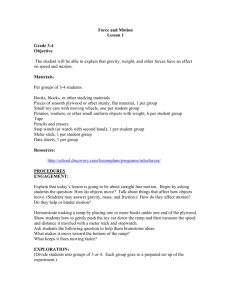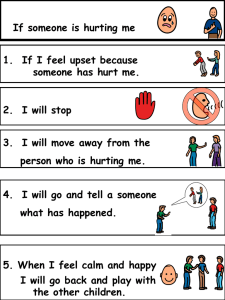Road safety data handling
advertisement
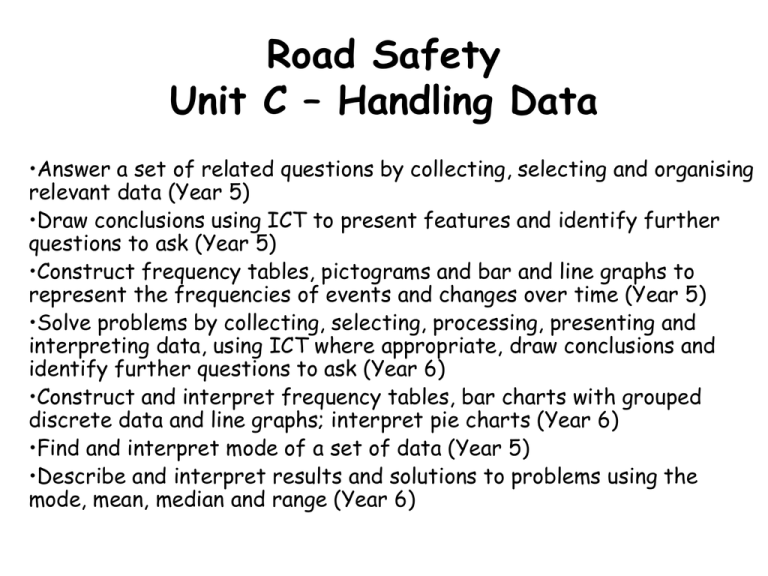
Road Safety Unit C – Handling Data •Answer a set of related questions by collecting, selecting and organising relevant data (Year 5) •Draw conclusions using ICT to present features and identify further questions to ask (Year 5) •Construct frequency tables, pictograms and bar and line graphs to represent the frequencies of events and changes over time (Year 5) •Solve problems by collecting, selecting, processing, presenting and interpreting data, using ICT where appropriate, draw conclusions and identify further questions to ask (Year 6) •Construct and interpret frequency tables, bar charts with grouped discrete data and line graphs; interpret pie charts (Year 6) •Find and interpret mode of a set of data (Year 5) •Describe and interpret results and solutions to problems using the mode, mean, median and range (Year 6) types of vehicles motorbike lorry car bicycle van bus frequency 120 100 80 60 40 20 0 motorbike types of vehicle lorry car bicycle van bus 0 20 40 60 frequency 80 100 Pictogram to show numbers of bicycles sold in one week Mon Tues Wed Thurs Days of the Week = 10 cycles Fri Sat Pictogram - Frequency Table Cycle helmet Number sold Trailblazer 24 Valhalla 37 Firefox 25 Valkyrie 16 Vixen 44 Rally 35 Roadrunner 41 Sonic III 29 Colours of cars passing school on Monday Spring/Summer 2006 Autumn/Winter 2006 Number of cars counted Number of cars counted 400 200 Number of people passing their driving test by gender Pie Chart Questions 1. What percentage of women passed their driving test in 1975 - 1976? 2. What percentage of men passed their driving tests between 1985 – 1986?? 3. How many more men than women passed their driving tests in 2002? 4. Estimate how many men passed their driving tests in the period shown altogether. 5. What might the data look like for 2006? Explain why you think this. Travelling to school summer? OR Travelling to school winter? Graphical Stories The water in the kettle takes 2 minutes to reach boiling point. It boils for another minute before it’s taken off the heat and the water cools down. Lewis walks to the start of the race and then sprints for the next 100 metres after which he sits down and recovers. David climbs up to the top of the slide. He jumps onto the slide, slides down and then jumps up and off at the end. Line graph to show a cyclist’s journey 60 Distance 40 (m) 20 0 10 20 Time (mins) 30 40 Line graph to show how far a toy car travelled down a ramp at different angles 80 60 Angle of ramp (°) 40 20 0 5 10 15 Distance travelled (cm) 20 Line Graph Questions 1. At what angle was the ramp when the toy car travelled 15cm? 2. How far did the toy car travel when the ramp was at 30°? 3. At what angle was the ramp when the toy car travelled 10cm? 4. When the ramp was at 55° how far did the toy car travel? 5. What do you think will happen if the ramp is set at 90°? 1. Scores achieved in road safety test: 18, 14, 10, 16, 15, 14, 11, 15, 14, 20, 18, 14, 11, 20 , 14 2. Distances travelled to school: 28, 76, 64, 23, 28, 28, 90, 23, 23, 27, 28, 23, 23, 34 3. Ages of children in Years 5 and 6: 11, 10, 11, 9, 11, 10, 9, 11, 11, 9, 10, 9, 9, 10 4. Shoe sizes: 2, 2, 2, 3, 5, 3, 5, 1, 13, 12, 2, 4, 2, 2, 3, 5, 1, 2, 2, 3, 4, 5, 1, 1, 3 5. Ages at which people passed their driving tests: 28, 27, 18, 35, 42, 19, 26, 32, 19, 26, 31, 26, 35 6. Distances travelled in metres by a clockwork toy: 3.4, 3.7, 3.6, 3.9, 3.1, 3.6, 3.4, 3.4, 3.8, 3.9, 3.2, 3.4, 3.8, 3.1, 3.7, 3.4, 3.2, 3.4
